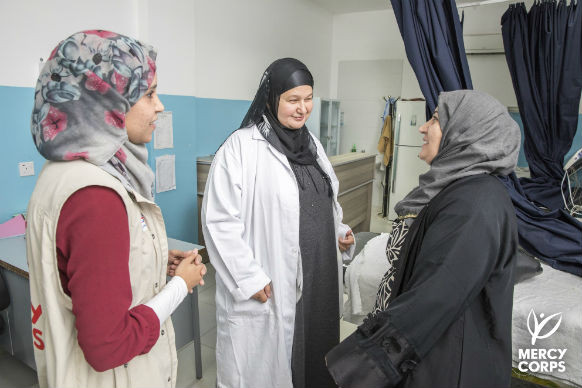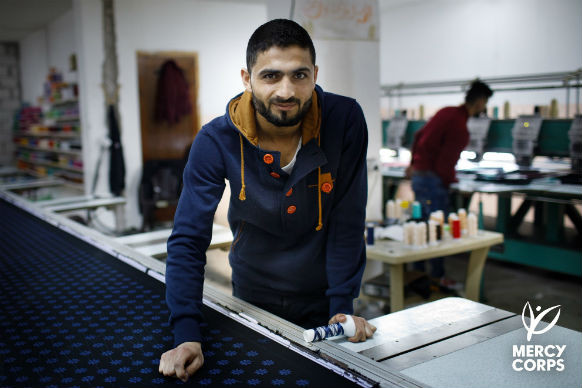Kakuma refugee camp in Northern Kenya is one of the largest and longest-standing refugee settlements in the world, and to many, it is the epitome of an intractable displacement crisis and an endless drain on the world’s aid budgets.
Yet this past summer, the International Finance Corporation published a landmark study revealing that the Kakuma camp and surrounding neighborhoods represent a $56 million market opportunity. It found what refugees and those who work with them have always known: that entrepreneurship and markets for consumer goods, real estate, education, telecommunications, and many other goods and services are flourishing in the area, despite significant practical and legal constraints.

This captures the essence of a quiet revolution underway in the humanitarian sector. Under the Global Compact on Refugees, refugees are no longer simply recipients of aid, but instead active participants in the economies and communities where they reside. And with this, business is no longer just a supporter, but an essential partner in turning the “refugee crisis” into an opportunity—for refugees, host countries, and businesses themselves.
Combining speed and endurance
This is a welcome shift, not only because the sheer scale of the challenge is too large for any one actor or sector, but also because the nature of displacement is changing. Of the more than 25 million refugees globally—the highest figure ever recorded—many are living in protracted situations with no immediate end in sight. In fact, the average time a refugee is in exile is more than a decade. Most also reside outside camp settings, relying less on donor aid, and more on local infrastructure and services and the political will of host-country governments.
Put simply, the refugee response is now both a sprint and a marathon. It demands speed and efficient interventions, alongside endurance and long-term development solutions. As Mercy Corps’ recent study on the coping strategies of Syrians living through conflict argued, the “aid sector’s definition of ‘lifesaving’ must evolve to include ‘livelihood saving.’”
Long-term dependence on humanitarian aid is neither practical nor desirable. Mercy Corps’ work in refugee host countries like Jordan, Uganda, and Bangladesh shows that refugees want to become self-reliant. They want to be able to support themselves and their families, and to build independent lives in their new homes, whether their stay is temporary or permanent.
Mobilizing business
The concept of self-reliance sounds good in theory but is difficult to do in practice. This is especially true where refugees face restrictions on their right to work, where they’ve left their belongings and networks to seek safety, or where they don’t speak the local language.
Humanitarian aid typically focuses on helping refugees survive but is not necessarily equipped to help them thrive in their new homes. Markets and businesses, whether small mom-and-pop shops or multinationals, form an important part of the answer to building self-reliance.
 Some refugees have been lucky enough to find more stable jobs that earn them a little income to buy food, and pay for schools, medicines, or rent. (Image courtesy of Mercy Corps)
Some refugees have been lucky enough to find more stable jobs that earn them a little income to buy food, and pay for schools, medicines, or rent. (Image courtesy of Mercy Corps)
Filippo Grandi, the UN High Commissioner on Refugees, reiterated this in a Financial Times op-ed last week, saying, “While global headlines on refugees can be dominated by alarmist views, there is a quieter revolution underway. This is driven by pragmatic, entrepreneurial people who see opportunities where others see threats, and who understand that refugees can lead productive lives in exile…”
A growing number of companies have committed to go beyond charitable contributions and use their core business assets to support refugee resilience. However, many are struggling to translate these commitments into tangible business models and outcomes. At the same time, the UN Refugee Agency (UNHCR) is trying to figure out how to support and enable these companies to do what they do well.
This dilemma was the starting point for the Business Fights Poverty Business and Refugees Challenge launched in April 2018 with support from Pearson and in partnership with UNHCR, Business Call to Action, Innovest Advisory, Mercy Corps, and Thomson Reuters Foundation. Our aim was to understand what it would take to mobilize more business to support refugee self-reliance and resilience.
Enablers of scale
Over the last six months, we have consulted more than 50 stakeholders and drawn on the rich experience and deep knowledge of our partners to identify 17 promising business models to help build refugee resilience, including digital education for refugee children, sourcing from refugee-owned or inclusive enterprises, and safe and sustainable off-grid energy solutions.
Beyond the models themselves, we learned about some of the factors that will help these models work in practice and scale. Here are three:
1. Identify benefits and incentives for host countries, and build both.
Refugees and displaced people are too often seen as a drain on resources, but often the reverse is true. Research shows that access to functioning markets is an important predictor of better household welfare. It also enables refugees to contribute to local economies that can have a positive multiplier effect on local employment and development. Since 2011, Syrians have invested nearly $334 million into more than 6,000 new formal companies in Turkey, and on average, these companies employ 9.4 people.
Despite these benefits, many host countries are reluctant to integrate refugees for fear that what they thought was a short-term solution could turn into a long-term problem. This is why it is important to create opportunities for refugees that also strengthen local economies and infrastructure, and support vulnerable groups among the local population.
For example, Pearson’s Every Child Learning partnership with Save the Children aims to improve the learning outcomes and wellbeing of refugee and local Jordanian children using gamification. As part of the partnership, Pearson collaborated with refugee and Jordanian children to design Space Hero (Batl Al Fada’a), a fun and engaging learning app to strengthen the math skills of children aged 9-12.
Ziad Ayoubi of UNHCR explained in an interview: “Host countries need to see that they will benefit from promoting refugee employment and entrepreneurship. When you can offer them additional development—more exports, more quality goods, and value chain development—they will be interested.” Some incentives could be foreign direct investment, reductions in tariffs, access to technology and innovation, and local employment opportunities.
 Syrian refugees have found ways to support themselves, setting up small businesses, or working for NGOs or in the community. (Image courtesy of Mercy Corps)
Syrian refugees have found ways to support themselves, setting up small businesses, or working for NGOs or in the community. (Image courtesy of Mercy Corps)
2. Use aid to catalyze markets and attract business.
Recent efforts by Mercy Corps and other organizations have shown that it is both possible and beneficial to use aid in a way that catalyzes markets, and enables businesses to make a positive contribution and create opportunities. In Uganda, for example, spending by the country’s more than one million South Sudanese refugees—many of whom have already been in exile for four or more years—is fueling growth in local marketplaces.
Yet many current aid strategies risk undermining, rather than supporting, local markets’ capacity to support refugees. Instead of traditional humanitarian aid models that give away supplies and services such as food and materials, Mercy Corps is trying to build up local market systems to meet these needs. For example, it is using cash-based assistance and matching local businesses’ needs with refugee skills so that earned income channels back into local markets.
Another example is in energy provision. The humanitarian sector has tended to provide free energy solutions to refugees. While this model might be appropriate during the early phases of an emergency response, it is not sustainable and will likely undermine local markets. As more companies like Pawame and BBOX develop off-grid solar energy solutions for refugees, there are opportunities to use aid to build the market for these solutions by supporting consumer-financing models, or helping integrate refugees as distributors or manufacturers of these energy solutions.
3. Advocate for laws and policies that encourage refugee self-reliance and business engagement.
Even the best models will fail if laws and policies hamper both the ability of businesses to respond to refugees and the ability for refugees to take advantage of them. That means ensuring that refugees are legally allowed to work, build businesses, and access capital and educational opportunities. It means ensuring that they have the information they need to make choices about their own future.
Laws that directly or indirectly restrict refugees’ ability to start and own a business exist in many countries. In Pakistan, for example, refugees cannot hold real estate or own a business without a Pakistani partner. In Ecuador, refugees have limited access to financial institutions, and in Zambia, there are high fees for refugee business start-ups. Of 25 UNHCR priority countries (those with the greatest numbers of refugees), only 16 allow refugees full access to their education systems at primary and secondary levels.
Some refugee-owned businesses may be in sectors that face export restrictions. In other cases, many refugees are not skilled in the sectors approved for refugee business activity. In still other cases, practical implementation or enforcement, such as administrative burden or fees for setting up a business, are the primary barriers.
Organizations working on these issues need to create clear recommendations for governments, including what a supportive legal framework looks like and practical steps to facilitate implementation. There are some examples emerging. In June 2016, Jordan allowed Syrians to apply for work permits through agricultural cooperatives, which enables them to work for more than one employer. This addressed the fact that individual employers have little incentive to apply for work permits when the labor is typically casual and varies from day to day. Companies can also consider advocating for strengthening refugee rights just as garment brands have done in lobbying for work permits for Syrian refugees in Turkey.
As the number of global refugees continue to rise, there is an urgent need for new ways of collaborating with business. Now is time for the Global Compact on Refugees to deliver on its promise.
Support SSIR’s coverage of cross-sector solutions to global challenges.
Help us further the reach of innovative ideas. Donate today.
Read more stories by Jessica Davis Pluess & Selena Victor.

